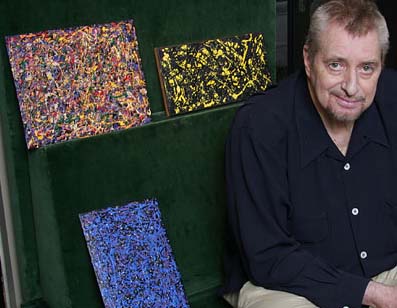Now that the Monterey Herald’s on the case, I think the Pebble Beach Pollock heist will be wrapped up pretty soon. Then we can get back to Finding The Warhols! Out of Angelo/Benjamin Amadio’s shifty, grifty interview with reporters Larry Parsons and Julia Reynolds, emerge details about the stolen Pollock and the “wholesale” art business Amadio ran for ten years:
A few minutes later, Amadio confessed that he knows “nothing about art.” But his role in the partnership with Kennaugh was “find it, buy it and sell it.” And he said he has good connections in the art world.
In 2001, Amadio said, research he did for a big-time art broker involved in the pending sale of a lot of Pollock paintings revealed that some of them weren’t authentic.
In gratitude, he said, a would-be buyer gave the men one of the real Pollocks — the same one they now say was taken from an upstairs office nook, where it was rolled up for storage. The broker, he said, wound up dying, an art world casualty of “cocaine overdose out West,” he said [from his rental house perched on the West coast].”
Ah, so in 2001, when he was 23, the guy who knows “nothing about art” authenticated an unknown hoard of purported Pollocks, and got “one of the real Pollocks” he identified as a thank you gift.
Who was this coke-snorting, big-time Pollock broker out West? I’m sure he must be very well-known to the Pollock-Krasner Foundation. Just think of the firestorm of attention and debate that erupted in 2005 when sexploitation filmmaker Alex Matter, whose parents were friends of the Pollock-Krasners, pulled a stack of small purported Pollocks from his late father’s East Hampton storage unit. [below: a NYT photo of Matter with some of his find.]

In fact, much of the story of the Matter Pollocks unfolds in Boston, where Amadio lived with his partner, Harvard physician Dr. Ralph Kennaugh. The NY Times reported in 2007 that pigments from Matter’s paintings were analyzed at the Harvard Art Museums and the MFA. When the pigments were found to have been manufactured long after the artist’s death in 1956–some as recently as 1996, after even Matter’s father’s death–Matter disputed the findings, and then commissioned a do-over in Williamstown, and then threatened to sue that guy over the results. And the whole trove was exhibited later that year at Boston’s College’s McMullen Museum.
Oh, look, as coverage of the local angle on the Matter paintings controversy picked up in 2007, the Boston Globe’s Geoff Edgers got Matter to admit that he had given “partial ownership” of his Pollock stash to dealer Ronald Feldman in exchange for help covering the “expenses associated with restoring, insuring and researching the works.”
So it could totally happen! Matter actually said he found the works in 2002. There are 22 canvases and 10 boards. Maybe he gave one of the largest canvases to Amadio for helping him clean out the storage unit, and kept the tiny, notebook-sized ones himself? [Q: Did Alex Matter OD in the desert recently?]
Of course, right in the middle of this Matter matter, David Geffen reportedly sold his Pollock painting, No. 5, 1948, for $140 million. That painting measures 4×8 feet, very close in size to Amadio’s Pollock. No. 5 is on fiberboard, though, not so easy to roll up and store behind your printer. To a collector-dealer of Amadio’s savvy and renown, I’m sure such a confluence of Pollock stories unfolding in his own backyard was a purely matter of deep, scholarly interest–and not a blueprint for concocting a giant Pollock scam of his own.
Pebble Beach art heist puts collectors in spotlight [montereyherald.com]
